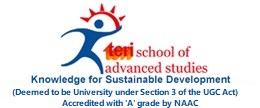
ANNOUNCEMENTS

| Date | News Title | Source |
| 18-July-2025 | 1 in 4 Indian married couples ... | The Indian Express |
| 23-June-2025 | Blended Learning: Driving educ... | The Pioneer |
| 22-June-2025 | All adults overweight in every... | |
| 21-June-2025 | TERI SAS Nurturing Global Sust... | The Interview World (Online) |
| 27-May-2025 | Eco-education trend grows: Sus... | India Today (Online- Education Desk) |
| 25-March-2025 | How water green credits can fu... | Hindustan Times (Opinion) |
| 23-February-2025 | Sustainable biz practices disc... | The Times of India (Online) |
| 21-February-2025 | Sangam fit for bath’, Enviro... | News9 (Online) |
| 12-February-2025 | A role for India in South-Sout... | The Hindu (Online) |
| 02-December-2024 | ICAR Findings Show 34% Decline... | ETV Bharat (Online) |
The intervention has bridged 63% ayacut gap and also helped stabilisation of ayacut
A report prepared by NITI Aayog with the support of TERI School of Advanced Studies, New Delhi, has recognised the restoration and revival of minor irrigation tanks taken up by the Telangana government as one of the best practices in irrigation water management.
The report observed public participation will lead to ownership and help in long-term sustainability of the interventions and suggested “restoration and maintenance of water resources should be a continual process and locals should be trained to manage their resources. The report prepared in August last was kept in the public domain by NITI Aayog recently.
The report comes as a breather of fresh air for the Irrigation Department, the implementing agency of Mission Kakatiya, after the Comptroller and Auditor General (CAG) report found shortcomings in the implementation including unrealistic targets, skewed prioritisation and meeting the intended targets such as silt removal, for the year ending March 2017.
Complimenting the objective of the intervention, the report stated that the government aims restoration of minor irrigation sources such as ponds and tanks to enhance development of minor irrigation infrastructure, strengthening community-based irrigation management in a decentralised manner for utilising 265 tmc ft water allocated for minor irrigation in the Godavari and Krishna river basins.
When contacted, Irrigation officials said the first phase of the programme was completed in all respects and pending work of second and third phases were in progress. Grounding and execution of work sanctioned in the fourth phase was also in progress.
The report said de-siltation of tanks, restoration of feeder channels, re-sectioning of irrigation channels, repairs to tank bunds, weirs and sluices and raising of full tank level (FTL) are being carried out wherever required. Further, the intervention had helped in increasing the storage capacity of tanks and other water bodies, made available water accessible to small and medium farmers, increased water retention capacity of the sources and improved on-farm moisture retention capacity.
The intervention has bridged 63% ayacut gap and also helped stabilisation of ayacut. Steps such as mixing of silt on farm land reduced use of chemical fertilizers and improved water retention capacity of the soil. An appreciable change was also observed in the nutritive values of the soil, development of fisheries and livestock and rise in the groundwater table in those area, the report said.
Plot No. 10, Institutional Area, Vasant Kunj, New Delhi - 110 070, India.
Tel. +91 11 71800222 (25 lines).
Website : www.terisas.ac.in
Email id : registrar@terisas.ac.in
© Copyright © 2025, TERI SAS, All rights reserved.
Visitors No.: 44752666 Since 2023


